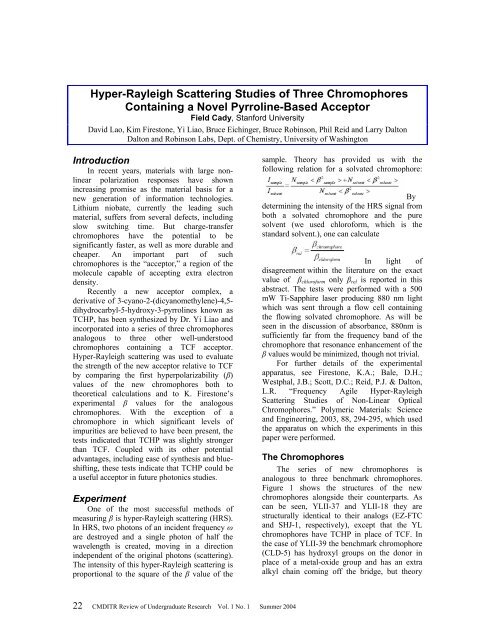CMDITR Review of Undergraduate Research - Pluto - University of ...
CMDITR Review of Undergraduate Research - Pluto - University of ...
CMDITR Review of Undergraduate Research - Pluto - University of ...
Create successful ePaper yourself
Turn your PDF publications into a flip-book with our unique Google optimized e-Paper software.
Hyper-Rayleigh Scattering Studies <strong>of</strong> Three Chromophores<br />
Containing a Novel Pyrroline-Based Acceptor<br />
Field Cady, Stanford <strong>University</strong><br />
David Lao, Kim Firestone, Yi Liao, Bruce Eichinger, Bruce Robinson, Phil Reid and Larry Dalton<br />
Dalton and Robinson Labs, Dept. <strong>of</strong> Chemistry, <strong>University</strong> <strong>of</strong> Washington<br />
Introduction<br />
In recent years, materials with large nonlinear<br />
polarization responses have shown<br />
increasing promise as the material basis for a<br />
new generation <strong>of</strong> information technologies.<br />
Lithium niobate, currently the leading such<br />
material, suffers from several defects, including<br />
slow switching time. But charge-transfer<br />
chromophores have the potential to be<br />
significantly faster, as well as more durable and<br />
cheaper. An important part <strong>of</strong> such<br />
chromophores is the “acceptor,” a region <strong>of</strong> the<br />
molecule capable <strong>of</strong> accepting extra electron<br />
density.<br />
Recently a new acceptor complex, a<br />
derivative <strong>of</strong> 3-cyano-2-(dicyanomethylene)-4,5-<br />
dihydrocarbyl-5-hydroxy-3-pyrrolines known as<br />
TCHP, has been synthesized by Dr. Yi Liao and<br />
incorporated into a series <strong>of</strong> three chromophores<br />
analogous to three other well-understood<br />
chromophores containing a TCF acceptor.<br />
Hyper-Rayleigh scattering was used to evaluate<br />
the strength <strong>of</strong> the new acceptor relative to TCF<br />
by comparing the first hyperpolarizability (β)<br />
values <strong>of</strong> the new chromophores both to<br />
theoretical calculations and to K. Firestone’s<br />
experimental β values for the analogous<br />
chromophores. With the exception <strong>of</strong> a<br />
chromophore in which significant levels <strong>of</strong><br />
impurities are believed to have been present, the<br />
tests indicated that TCHP was slightly stronger<br />
than TCF. Coupled with its other potential<br />
advantages, including ease <strong>of</strong> synthesis and blueshifting,<br />
these tests indicate that TCHP could be<br />
a useful acceptor in future photonics studies.<br />
Experiment<br />
One <strong>of</strong> the most successful methods <strong>of</strong><br />
measuring β is hyper-Rayleigh scattering (HRS).<br />
In HRS, two photons <strong>of</strong> an incident frequency ω<br />
are destroyed and a single photon <strong>of</strong> half the<br />
wavelength is created, moving in a direction<br />
independent <strong>of</strong> the original photons (scattering).<br />
The intensity <strong>of</strong> this hyper-Rayleigh scattering is<br />
proportional to the square <strong>of</strong> the β value <strong>of</strong> the<br />
sample. Theory has provided us with the<br />
following relation for a solvated chromophore:<br />
By<br />
determining the intensity <strong>of</strong> the HRS signal from<br />
both a solvated chromophore and the pure<br />
solvent (we used chlor<strong>of</strong>orm, which is the<br />
standard solvent.), one can calculate<br />
In light <strong>of</strong><br />
disagreement within the literature on the exact<br />
value <strong>of</strong> β chlor<strong>of</strong>orm only β rel is reported in this<br />
abstract. The tests were performed with a 500<br />
mW Ti-Sapphire laser producing 880 nm light<br />
which was sent through a flow cell containing<br />
the flowing solvated chromophore. As will be<br />
seen in the discussion <strong>of</strong> absorbance, 880nm is<br />
sufficiently far from the frequency band <strong>of</strong> the<br />
chromophore that resonance enhancement <strong>of</strong> the<br />
β values would be minimized, though not trivial.<br />
For further details <strong>of</strong> the experimental<br />
apparatus, see Firestone, K.A.; Bale, D.H.;<br />
Westphal, J.B.; Scott, D.C.; Reid, P.J. & Dalton,<br />
L.R. “Frequency Agile Hyper-Rayleigh<br />
Scattering Studies <strong>of</strong> Non-Linear Optical<br />
Chromophores.” Polymeric Materials: Science<br />
and Engineering, 2003, 88, 294-295, which used<br />
the apparatus on which the experiments in this<br />
paper were performed.<br />
The Chromophores<br />
The series <strong>of</strong> new chromophores is<br />
analogous to three benchmark chromophores.<br />
Figure 1 shows the structures <strong>of</strong> the new<br />
chromophores alongside their counterparts. As<br />
can be seen, YLII-37 and YLII-18 they are<br />
structurally identical to their analogs (EZ-FTC<br />
and SHJ-1, respectively), except that the YL<br />
chromophores have TCHP in place <strong>of</strong> TCF. In<br />
the case <strong>of</strong> YLII-39 the benchmark chromophore<br />
(CLD-5) has hydroxyl groups on the donor in<br />
place <strong>of</strong> a metal-oxide group and has an extra<br />
alkyl chain coming <strong>of</strong>f the bridge, but theory<br />
22 <strong>CMDITR</strong> <strong>Review</strong> <strong>of</strong> <strong>Undergraduate</strong> <strong>Research</strong> Vol. 1 No. 1 Summer 2004




